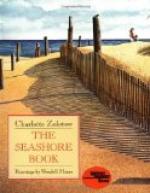Besides these spines and suckers, the Sea-urchin owns another set of tools. Scattered over it, among the spines, are many tiny rods tipped with little teeth or pincers. You will not be able to see them, except under a magnifying glass. Of what use are these strange little pincers or rods? It is thought that the Urchin uses them in several ways. They may help in capturing small prey, or they may be used when the creature has to fight a larger enemy. They are also certainly of use as cleansing tools. That is to say, they can pick off tiny scraps of weed or dirt which settle on the animal’s body. Some Starfishes also own pincers of this sort, but they are not so perfect as those of the funny little Urchin. We must not forget that all these spines, tube-feet, and pincers are worked by a set of muscles.
In the centre of the Urchin’s shell is its mouth. The Starfish, we found, had a terrible mouth, but that of the Urchin is worse still. Not only is it of great size, but it is fitted with strong jaws and five long, sharp teeth, You may see them poking out from the mouth of the animal, and feel for yourself how hard they are.
There is a great deal more to know about Five-fingers; and the Sea-urchin still has his secrets which no one can explain. We have but glanced at their story in this lesson; but you can see that the Starfish, lying limp on the sands, is not so dull as it looks.
EXERCISES
1. Where is the mouth of the Starfish placed?
2. Describe how the Starfish moves.
3. How does the Starfish feed on the oyster?
4. Why is the Brittle Star given that name?
5. How do the Starfish and Sea-urchin keep themselves clean?
LESSON II.
A STROLL BY THE SEA.
The sea and the land are always at war. When you are at the seaside, with spade and bucket to make “castles” and “pies” of the sand, you can see and hear the battle.
A wave comes rolling smoothly on towards the shore. It reaches the land and can go no further, and then, with a roar and a crash and splash of sparkling foam, it breaks. It spreads into a sheet of foaming water, and, after rushing as far as it can up the beach, it seethes back as the next wave takes up the battle.
What a grinding and tearing, as wave after wave is hurled at the land! That is the battle-cry of the land and sea! Most of the pebbles and the sand on the beach have been won from the land in the great fight. We might call them the spoils of war. Once they formed part of the solid land, the rock or cliff. Now they are loose fragments spread for mile after mile round our coast.
Every wave takes them up and has fine fun with them. Pebbles and sand are picked up, swirled along, and thrown at the shore. They are sucked back as the wave is broken by the land. And then the following wave takes them, grinds them and scrubs them together. Thus they are jostled hither and thither, up and down the coast; and, as a result of the long, long fight, rocks and cliffs become pebbles, sand, or mud.




